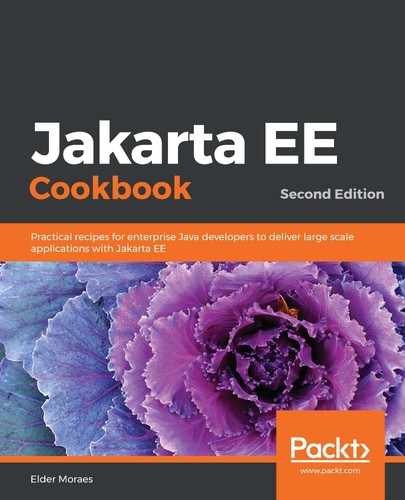Let's understand our first Dockerfile:
FROM openjdk:8-jdk
The FROM keyword will ask Docker to pull the openjdk:8-jdk image, but what does this mean?
This means that there's a registry somewhere where Docker will find prebuilt images. If there's no image registry in your local environment, it will search for it in Docker Hub, the official and public Docker registry in the cloud.
When you say that you are using a pre-built image, this means that you don't need to build the whole Linux container from scratch. There's already a template that you can rely on:
ENV GLASSFISH_HOME /usr/local/glassfish
ENV PATH ${GLASSFISH_HOME}/bin:$PATH
ENV GLASSFISH_PKG glassfish-5.1.0.zip
ENV GLASSFISH_URL https://www.eclipse.org/downloads/download.php?file=/glassfish/glassfish-5.1.0.zip&r=1
RUN mkdir -p ${GLASSFISH_HOME}
WORKDIR ${GLASSFISH_HOME}
Here are just some environment variables to help with the coding process:
RUN set -x
&& curl -fSL ${GLASSFISH_URL} -o ${GLASSFISH_PKG}
&& unzip -o $GLASSFISH_PKG
&& rm -f $GLASSFISH_PKG
&& mv glassfish5/* ${GLASSFISH_HOME}
&& rm -Rf glassfish5
The RUN clause in Dockerfiles executes some bash commands inside the container when it has been created. Here, GlassFish is being downloaded and then prepared in the container:
RUN addgroup glassfish_grp
&& adduser --system glassfish
&& usermod -G glassfish_grp glassfish
&& chown -R glassfish:glassfish_grp ${GLASSFISH_HOME}
&& chmod -R 777 ${GLASSFISH_HOME}
For safety, we define the user that will hold the permissions for GlassFish files and processes:
COPY docker-entrypoint.sh /
RUN chmod +x /docker-entrypoint.sh
Here, we are including a bash script inside the container so that we can perform some GlassFish administrative tasks:
#!/bin/bash
if [[ -z $ADMIN_PASSWORD ]]; then
ADMIN_PASSWORD=$(date| md5sum | fold -w 8 | head -n 1)
echo "##########GENERATED ADMIN PASSWORD: $ADMIN_PASSWORD
##########"
fi
echo "AS_ADMIN_PASSWORD=" > /tmp/glassfishpwd
echo "AS_ADMIN_NEWPASSWORD=${ADMIN_PASSWORD}" >> /tmp/glassfishpwd
asadmin --user=admin --passwordfile=/tmp/glassfishpwd change-admin-password --domain_name domain1
asadmin start-domain
echo "AS_ADMIN_PASSWORD=${ADMIN_PASSWORD}" > /tmp/glassfishpwd
asadmin --user=admin --passwordfile=/tmp/glassfishpwd enable-secure-admin
asadmin --user=admin stop-domain
rm /tmp/glassfishpwd
exec "$@"
After copying the bash file into the container, we can go to the final block:
USER glassfish
ENTRYPOINT ["/docker-entrypoint.sh"]
EXPOSE 4848 8080 8181
CMD ["asadmin", "start-domain", "-v"]
From the preceding code, we can see the following:
- The USER clause defines the user that will be used from this point in the file. This is great because, from there, all the tasks will be completed by the glassfish user.
- The ENTRYPOINT clause will execute the docker-entrypoint.sh script.
- The EXPOSE clause will define the ports that will be available for containers that use this image.
- The CMD clause will call the GlassFish script that will initialize the container.
Now, let's understand our second Dockerfile:
FROM eldermoraes/gf-jakartaee-jdk8
We need to take the same considerations regarding the prebuilt image into account, but here, the image was made by you. Congratulations!
ENV DEPLOYMENT_DIR ${GLASSFISH_HOME}/glassfish/domains/domain1/autodeploy/
Here, we are building an environment variable to help with the deployment process. This is done in the same way as it's done for Linux systems:
COPY app.war ${DEPLOYMENT_DIR}
This COPY command will literally copy the app.war file to the folder defined in the DEPLOYMENT_DIR environment variable.
From here, you are ready to build an image and create a container. The image builder is self-explanatory:
docker build -t eldermoraes/gf-jakartaee-cookbook .
Let's check the docker run command:
docker run -d --name gf-jakartaee-cookbook
-h gf-jakartaee-cookbook
-p 80:8080
-p 4848:4848
-p 8686:8686
-p 8009:8009
-p 8181:8181
eldermoraes/gf-jakartaee-cookbook
If we break this down, this is what the various elements of the command mean:
- -h: Defines the hostname of the container.
- -p: Defines which ports will be exposed and how this will be done. This is useful, for example, when more than one container is using the same port by default – you just use them differently.
- eldermoraes/gf-jakartaee-cookbook: The reference to the image you just built.
